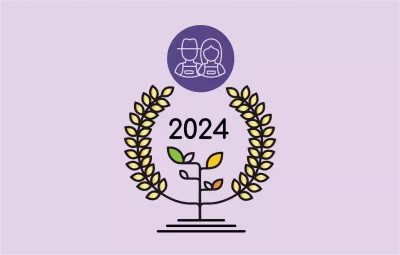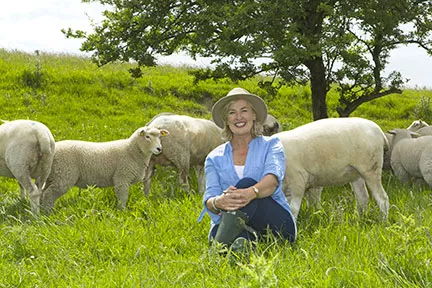General information
RDP Priority
- P6. Social inclusion and local development
RDP Focus Area
- 6B: Local development
RDP Measure
- M19: LEADER/CLLD
Beneficiary type
- Producer group / cooperative / farmer’s association
Summary
In 2019, the Galway Wool Co-op was set up to restore the cultural integrity of native Irish wool and establish niche market opportunities domestically and internationally for this bio-fibre.
This innovative virtual cooperative is the first of its kind in Ireland. Funding received via the LEADER programme in 2021 towards the development of a website (which acts as the co-op’s e-commerce marketplace and trading platform), as well as promotional materials, has enabled the initiative to have a countrywide impact.
The co-op sought buyers interested in preserving this rare wool in Ireland, resulting in a substantial increase in the base price of wool from EUR 0.20/kg to EUR 2.50. By harnessing the goodwill of growers to draw wool from throughout Ireland, a newly created community now works diligently together to bring awareness to the consumer of the variety of applications for strong wool.
Sheep farmers in rural Irish communities are now gaining a revenue stream from wool production and have the capacity to reinvest their earnings into every facet of small towns and villages. The crafts industry in Ireland has once again been afforded an opportunity to work with real native Irish wool and the authenticity that this gives their offering.
Results
- 1 660 % growth in the sales price and farm-gate price of Galway wool through extensive marketing and customer discovery.
- Raising of the revenue for Irish Galway wool growers from EUR 0.15/kg to EUR 2.50/kg.
- Increased sales and revenue generated by farmers in rural areas, with improvements in the quality of the breeding stock.
- Each kilogramme of Galway wool grown takes up to two kilogrammes of carbon from the atmosphere. A typical Galway fleece weighs up to ten kilogrammes, so this acts as a fantastic carbon sink.
- The project has created a community of growers who now share a renewed pride in their wool and breeding stock.
- The project has also worked to create awareness around the massive potential for the LEADER-funded wool co-op model to be replicated, enabling all wool growers across Europe to have more control over the destination of their wool and its huge array of uses.

Promoter
Galway Wool Co-op
Funding
Total budget: 27 115 (EUR)
EAFRD: 12 771 (EUR)
National/Regional: 7 565 (EUR)
Private/Own funds: 6 779 (EUR)
Resources
Documents
Context
In June 2021, Blátnaid Gallagher, who farms near the historical village of Aughrim in east County Galway, used LEADER funding to help support the Galway Wool Co-op (established in 2019). At that time, it was felt that consumers in Ireland and, indeed, across Europe had little or no information about the origin of their wool in apparel and home furnishings.
In a world of growing interest in bio-fibre versus poly-fibre, the consumer was, and is, purchasing Irish and European woollen products made entirely from wool imported from the southern hemisphere. These are often grown on industrial-scale farms where there can be little or no regard for the welfare of the sheep. Merino wool harvested at the lowest possible base price is typically the fibre of choice across Europe and beyond.

At the outset of this project, wool growers in Ireland were being tasked with shearing their sheep, often with the prospect of receiving as little as EUR 0.30 for the fleece. In Ireland, there is a booming woollen sector, but across its rural communities, sheep farmers are unrepresented.
Focusing on the incredible heritage of Ireland’s native breed of sheep, the Galway Wool Co-op believed that with the support of LEADER, it could highlight the imbalance that exists and, with its close association with the Irish Aran sweater, once again restore the value of this wool.
Objectives
The main issue to be tackled was raising the base price of Galway wool from EUR 0.20 to EUR 2.50. It was also important to harvest wool that otherwise would be sent to the United Kingdom and disposed of as 'Category 3' waste.
As the project progressed, one of the main priorities became helping increase the number of family farms across Ireland that are actively growing wool. When the project was first launched, there were no family farms anywhere in Ireland that were being recognised as wool-growers.
A potential peripheral benefit that was identified was to help to provide tourism opportunities for small artisan crafters to demonstrate the real Irish wool experience.
Activities
A cornerstone of the project, and its success, was the funding received through LEADER towards the Galway Co-op branding, website, promotional video and associated promotional materials.

The co-op applied for LEADER funding and met the project officer to identify the core needs of the project and the potential associated costs. They then drew up a business plan and began the application for funding. At the same time, a tendering process was launched for all four aspects of the project: brand establishment, website, promotional video and marketing material.
The website and marketing campaign were launched in mid-2021 which gave the Galway Wool Co-op the opportunity to tell the real story behind native Irish wool, allowing it to reach potential customers all around the world, sharing the story of its wool, its growers and the rural communities that were being supported.
Over six months, the Galway Wool Co-op collaborated closely with an e-commerce and branding agency by the name of YUM to establish the brand and effectively communicate the authenticity and traceability of this bio-fibre. The website and promotional materials have enabled Galway Co-op to organise an annual wool collection and promotional event known as 'The Meitheal', which started in 2021.
Since the beginning of the project started, Blátnaid Gallagher, secretary of the Galway Wool Co-op, has spoken at the Food, Farming and Countryside Commission, and been a panellist at the European Forum of the European Coordination of Let’s Liberate Diversity. The work of the co-op has featured in four national television programmes in Ireland, in national print and radio and has been delivered as part of a textile module at The National College of Art and Design Dublin and the Art and Design programme at the Atlantic University Galway.
Galway Wool Co-op also joined forces with Fibreshed Ireland (a supportive network of farmers, crafters, processors and designers in facilitating an Irish regenerative fibre system based on local fibre, dyes and labour), Felt Maker Ireland (a voluntary craft guild with members throughout the country) and will soon be featured as a good practice case study for PACESETTERS Horizon Europe Project.
Over the five years that the project has been running, 42 new members have been recruited to the Galway Wool Co-op.
Main results
The co-op has achieved 1 660 % growth in the sales price and farm gate price of Galway wool through extensive marketing and customer discovery and raised the revenue for Irish Galway wool growers from EUR 0.15/kg to EUR 2.50/kg. Increased sales and revenue have also been generated by farmers in rural areas, with improvements in the quality of the breeding stock.
From an environmental point of view, each kilogramme of Galway wool grown takes up to two kilogrammes of carbon from the atmosphere. A typical Galway fleece weighs up to ten kilogrammes, so this acts as a fantastic carbon sink. Undyed, the Galway yarn is fully biodegradable, and as such, it can be returned to the soil, inputting an abundance of nutrients and supporting good soil health. Unlike many other textile wools harvested in the southern hemisphere, wool from Galway sheep is shorn for the welfare of the sheep and not as a commercial fibre crop.
The project has created a community of growers who now share a renewed pride in their wool and breeding stock. The group meets annually at the harvest to share traditional music and song and dance, celebrating the power of the people to drive change in our woollen markets.
In starting the co-op and retaining this bio-fibre in Ireland, the project has also worked to create awareness around the massive potential for the LEADER-funded wool co-op model to be replicated, enabling all wool-growers across Europe to have more control over the destination of their wool and its huge array of uses.
Key lessons
The main priorities have been obtaining a fair price for wool growers at the farm gate, which also goes a long way to restoring the cultural integrity of native Irish Galway wool.
The driving force behind the project, Blátnaid Gallagher, is an ambassador of the Female-Led Innovation in Agriculture and Rural Areas (FLIARA) project. This has given her the opportunity to share her story and for it to potentially become a pilot project for wool growers all over the EU.
The co-op has also harnessed the power of its newly created website, social media and other promotional materials to create a virtual co-op, which has drastically increased awareness of the landscape of wool and facilitated engagement between key stakeholders.
Blátnaid Gallagher

